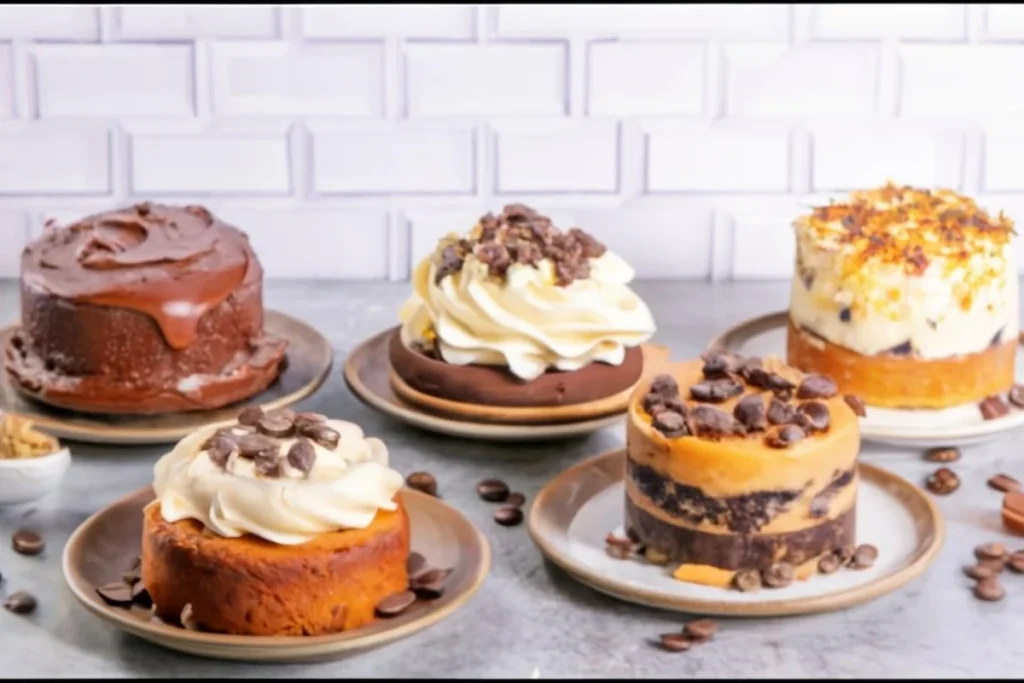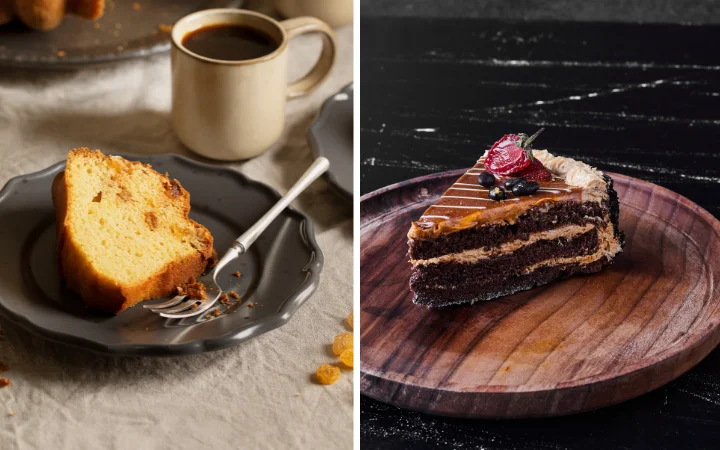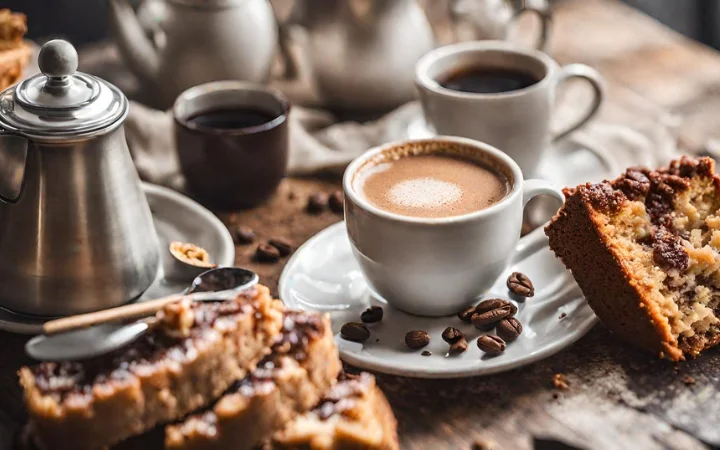We explore the intriguing world of coffee cake and its uniqueness compared to regular cake. We uncover coffee cake’s unique ingredients, flavors, cultural significance, and pairing possibilities.Join our journey through coffee cake’s history, varieties, and secrets, answering FAQs along the way.
Introduction to Coffee Cake and Regular Cake
Rich flavors and diverse varieties of cakes have long captured the hearts of many, making them staples of celebration and indulgence, much like the delicious chocolate cherry dump cake featured on our site. Among these, coffee cake emerges as a distinct category, offering a unique experience that sets it apart from regular cake. In this section, we explore the popularity of cakes in the U.S. and the special appeal of coffee cake, as detailed in this comprehensive article on coffee cake.
The Popularity of Cakes in the U.S.
In the U.S., cakes symbolize joy, celebration, and comfort, more than just desserts. Cakes, accounting for much bakery sales, come in flavors from classic chocolate to adventurous funfetti. This diversity shows America’s love for cakes, present at birthdays, weddings, holidays, and more.
The Unique Appeal of Coffee Cake
Despite its name, coffee cake usually lacks coffee as an ingredient. It gets its name as a popular coffee accompaniment. Its crumbly, cinnamon streusel topping sets coffee cake apart. Coffee cake’s topping, unlike regular cakes’ frosting or glaze, bakes with the cake, simplifying preparation. This distinctive feature, along with its ease of preparation, makes coffee cake a beloved choice for both bakers and connoisseurs alike.
In the next section, we’ll dive deeper into the key differences between coffee cake and regular cake, examining their ingredients, flavor profiles, and more. Stay tuned as we unravel the delightful contrasts that make each type of cake unique.

Key Differences Between Coffee Cake and Regular Cake
When exploring the question, ‘What makes coffee cake different from cake?’, it’s essential to delve into the key differences that set these two types of cakes apart, similar to the contrast seen in our chocolate pound cake guide, as highlighted in these delicious coffee cake recipes. From their ingredients to their flavor profiles and preparation methods, each has its own unique characteristics.
Ingredients and Flavor Profiles
Firstly, the ingredients used in coffee cake and regular cake can vary significantly. While both may contain common elements like flour, sugar, eggs, and butter, coffee cake often includes additional components such as sour cream or yogurt, which contribute to its moist texture. Moreover, coffee cake is renowned for its cinnamon-infused flavor, a hallmark that distinguishes it from the more varied flavor profiles of regular cakes, which range from fruity to chocolatey.
Toppings and Textures
Another notable difference lies in the toppings and textures. Coffee cake is famous for its crumbly streusel topping, made from a blend of flour, sugar, butter, and cinnamon. This topping not only adds a delightful crunch but also a layer of sweetness and spice. In contrast, regular cakes are typically adorned with smooth frostings or glazes, offering a different sensory experience.
Preparation and Baking Techniques
Furthermore, the preparation and baking techniques for coffee cake and regular cake differ. Coffee cake is simpler to prepare, as its streusel topping is baked along with the cake, eliminating the need for additional decorating steps. Regular cakes, on the other hand, often require more intricate decoration after baking, such as frosting application and layering.
In summary, the differences between coffee cake and regular cake are evident in their ingredients, flavor profiles, toppings, and preparation methods. These distinctions contribute to the unique appeal of each type, making them beloved choices for various occasions and preferences. As we continue to explore “What makes coffee cake different from cake?”, we’ll next examine the historical and cultural context of coffee cake.

Historical and Cultural Context of Coffee Cake
Understanding ‘What makes coffee cake different from cake?’ also involves exploring its historical and cultural context, as we’ve done in our ultimate guide to coffee cake., as detailed in this article about the history of coffee cake. The origins and evolution of coffee cake, along with its significance in different cultures, offer fascinating insights into this beloved treat.
Origins and Evolution
Tracing its roots back to various European countries, people traditionally served coffee cake with coffee or tea. Over time, immigrants brought their coffee cake recipes to America, where they evolved and adapted to local tastes and ingredients. This evolution has led to a diverse range of coffee cake styles, each reflecting the cultural influences and culinary traditions of its origin.
Coffee Cake in Different Cultures
In different cultures, coffee cake takes on various forms and meanings. For instance, in Germany, coffee cake (known as “Kaffekuchen”) is often a yeast-based cake, while in Scandinavian countries, it might include cardamom and other spices. These cultural variations showcase the adaptability of coffee cake and its ability to resonate with people from different backgrounds.
Coffee Cake Traditions and Celebrations
Certain traditions and celebrations also associate with coffee cake. In many households, it is a staple for brunches, family gatherings, and holiday celebrations. The ritual of enjoying coffee cake with a warm beverage has become a symbol of hospitality and comfort, making it a cherished part of social occasions.
The historical and cultural context of coffee cake enriches our understanding of “What makes coffee cake different from cake?”. It highlights not only the culinary differences but also the social and cultural significance of this delightful treat. Next, we will explore the varieties and recipes of coffee cake, further delving into its diverse and delicious world.
Varieties and Recipes of Coffee Cake
As we continue to explore ‘What makes coffee cake different from cake?’, it’s important to delve into the various types of coffee cake and the recipes that make each one unique, like the ones in our complete baking guide for chocolate coffee cake, like those found in these creative coffee cake recipes. From classic versions to innovative twists, coffee cake offers a wide range of flavors and textures to suit different tastes.
Classic Coffee Cake Recipes
The classic coffee cake is characterized by its moist, tender crumb and a generous layer of streusel topping. Traditional recipes often include ingredients like sour cream or buttermilk, which contribute to the cake’s rich texture. The streusel topping, a blend of flour, sugar, butter, and cinnamon, is what truly sets it apart, providing a crunchy contrast to the soft cake beneath.
Innovative Twists on Traditional Coffee Cake
Innovative bakers have taken the traditional coffee cake and added their own creative twists. These variations might include the addition of fruits like apples or blueberries, nuts such as walnuts or pecans, or even swirls of chocolate or caramel. These modern takes on coffee cake demonstrate its versatility and ability to adapt to contemporary culinary trends.
Regional Variations of Coffee Cake
Around the world, coffee cake takes on different forms and flavors, reflecting regional ingredients and preferences. For example, in some European countries, coffee cake may be yeast-based and less sweet, while in the United States, it’s typically a sweet, crumb-topped cake. These regional variations contribute to the rich tapestry of coffee cake varieties available globally.
Exploring the varieties and recipes of coffee cake helps us appreciate the diversity and creativity that answer the question, “What makes coffee cake different from cake?”. In the next section, we will examine the nutritional aspects and dietary considerations of coffee cake, offering insights for health-conscious consumers and those with dietary restrictions.

Nutritional Aspects and Dietary Considerations
In our quest to understand ‘What makes coffee cake different from cake?’, it’s crucial to consider the nutritional aspects and dietary considerations of both, similar to how we approach recipes like our healthy chicken gnocchi soup, as outlined in this nutritional information . While indulging in these delicious treats, being mindful of their nutritional content and available alternatives can help cater to various dietary needs and preferences.
Caloric Content and Ingredients
Typically, coffee cake and regular cake are similar in their basic ingredients, which include flour, sugar, eggs, and butter. However, coffee cake often contains additional elements like sour cream or yogurt, contributing to its moist texture but also adding to the caloric content. It’s important for those monitoring their calorie intake to be aware of these differences.
Gluten-Free and Vegan Options
For individuals with dietary restrictions, such as gluten intolerance or vegan preferences, there are alternative recipes for coffee cake and regular cake. Gluten-free versions can be made using alternative flours like almond or coconut flour. Similarly, vegan coffee cakes substitute eggs and dairy with plant-based ingredients, ensuring that everyone can enjoy these delightful treats.
Healthy Alternatives and Modifications
Health-conscious bakers have developed recipes that reduce the sugar and fat content in coffee cake and regular cake, making them more suitable for a balanced diet. These modifications might include using natural sweeteners like honey or maple syrup, incorporating whole grains, and reducing the amount of butter or oil. Such alternatives provide a healthier way to enjoy these cakes without compromising on taste.
Understanding the nutritional aspects and dietary considerations is an important part of exploring “What makes coffee cake different from cake?”. It allows us to enjoy these treats in a way that aligns with our health goals and dietary needs. Next, we will explore the art of pairing coffee cake with beverages, enhancing the overall culinary experience.
Pairing Coffee Cake with Beverages
A key aspect of understanding ‘What makes coffee cake different from cake?’ involves exploring the best ways to pair coffee cake with beverages, as suggested in these beverage pairings. The right drink can enhance the flavors of the cake, creating a harmonious and delightful culinary experience.
The Classic Coffee and Cake Combo
Pairing coffee cake with coffee traditionally creates a match made in culinary heaven. The rich, bold flavors of coffee complement the sweet, cinnamon-infused taste of the cake, creating a perfect balance. Whether it’s a strong espresso or a milder brew, coffee is the ideal companion to coffee cake, especially during breakfast or brunch.
Tea and Other Beverage Pairings
For those who prefer tea, coffee cake pairs wonderfully with a variety of teas. Black tea, with its robust flavor, stands up well to the sweetness of the cake, while herbal teas offer a lighter, more refreshing option. Additionally, coffee cake can be enjoyed with other beverages like milk, hot chocolate, or even a glass of dessert wine, providing diverse pairing possibilities.
Tips for the Perfect Pairing
When pairing coffee cake with beverages, consider the flavor profile of both the cake and the drink. A sweeter cake might pair better with a less sweet beverage, and vice versa. Experimenting with different combinations can lead to delightful discoveries and enhance the overall enjoyment of coffee cake.
Pairing coffee cake with the right beverage is an art that adds depth to the question, “What makes coffee cake different from cake?”. It’s not just about the cake itself, but how it interacts with other elements to create a complete sensory experience. In the final section, we will address frequently asked questions about coffee cake, providing valuable insights and tips for enthusiasts and bakers alike.

Frequently Asked Questions
In this final section, we address some common queries related to “What makes coffee cake different from cake?”, as answered in these frequently asked questions . These FAQs provide additional insights and tips for those interested in learning more about this delightful treat.
Common Queries About Coffee Cake
- Does it always contain coffee?
Contrary to its name, coffee cake usually does not include coffee as an ingredient. It’s called coffee cake because it’s traditionally served with coffee. - Can it be made in different flavors?
Absolutely! While the classic coffee cake has a cinnamon flavor, you can experiment with various ingredients like fruits, nuts, and spices to create different flavors. - Is it suitable for special diets?
Yes, there are many recipes available for gluten-free, vegan, and healthier versions of coffee cake, catering to different dietary needs.
Expert Answers and Tips
- Making the Perfect Streusel Topping:
The key to a great streusel topping is the right balance of flour, sugar, butter, and cinnamon. It should be crumbly and not too wet. - Storing it:
You can store coffee cake at room temperature for a few days or in the refrigerator to maintain its freshness longer. It can also be frozen for extended storage. - Serving it:
Coffee cake is best served at room temperature or slightly warmed, making it a versatile option for various occasions.
In conclusion, understanding “What makes coffee cake different from cake?” involves exploring its unique characteristics, historical context, varieties, nutritional aspects, and ideal pairings. This comprehensive guide not only answers the key question but also celebrates the rich and diverse world of coffee cake. Whether you’re a baking enthusiast or simply a lover of this delightful treat, there’s always something new and exciting to discover about coffee cake.
Conclusion: Embracing the Distinctive World of Coffee Cake
In summarizing our exploration of “What makes coffee cake different from cake?”, we’ve uncovered the unique aspects that make coffee cake a beloved treat. Its signature streusel topping and moist texture set it apart from regular cake, offering a distinct culinary experience.
We’ve seen how coffee cake’s history and cultural significance reflect its versatility across different regions and traditions. Its adaptability to various dietary needs, including gluten-free and vegan options, ensures that everyone can enjoy this delightful treat.
Pairing coffee cake with coffee or tea enhances flavors, ideal for gatherings or indulgence. Addressing FAQs about coffee cake offers insights for baking enthusiasts.
In conclusion, our coffee cake journey highlights its unique charm and appeal. As a hospitality and creativity symbol, coffee cake brings joy and comfort to its enjoyers.

